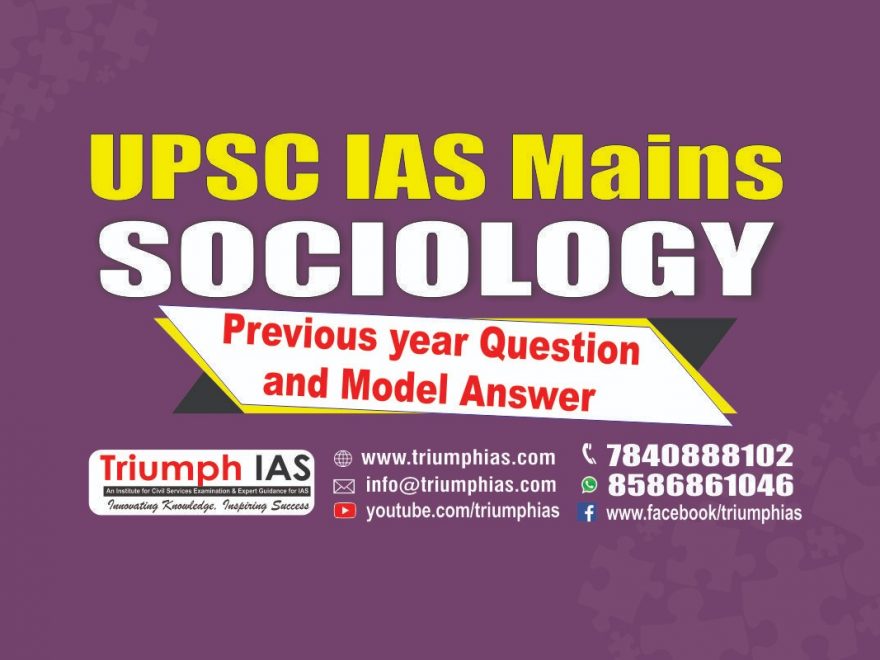Relevance: Sociology Paper II: Religion and Society: Problems of religious minorities.
Model Answer
Arnold Rose, defines minority as ‘a group of people differentiated from others in the same society by race, nationality, religion or language, who think of themselves as differentiated group and are thought of by others as a differentiated group with negative connotations. Further, they are relatively lacking in power and hence are subjected to certain exclusions, discrimination and other differential treatments’
Jagnath Pathy, has also listed out the defining properties of minority group, they being; a) subordinate in some way to the majority b) distinguishable from the majority on the basis of cultural or physical features c) collectively being regarded and treated as different and inferior on the basis of these features d) excluded from the full participation in the life of society.
The Constitution of India uses the term minority but does not define it anywhere . The Constitution recognizes two types of minorities based on language/and or religion. The Judiciary has so far depended on the statistical criterion. Any community that does not constitute 50% in the state is called a minority.
The Constitution of India has however provided the minority groups with many safeguards. The concept of secularism is enshrined in the Preamble and provisions of Articles 30 protect the rights of the minorities.
The National Commission for Minorities undertakes review of the implementation of the policies formulated by the State with regard to minorities. Despite all these safeguards ensured by the Constitution in addition to secularism mooted in popular ideology, the minorities have had to face many problems.
The minority problem is identified majorly with the Muslim community, though incidents like Kandhamal riots show that other religious minorities often suffer on account of ‘ majoritarianism.’
The NSSO (55th round) showed that a larger proportion of Muslims suffered from low levels of consumption. A large number of them work either as daily labourers, or as owners of micro-enterprises as small as vending out of push carts.
Dipankar Gupta notes that they move from ‘poverty to poverty’. Muslims are ‘below’ the national average in literacy and education. Most Muslims in urban areas are artisans. They consider it beyond their means and a waste of time to send their children to schools.
Moreover, there is the perception that the children will not get a job anyway on account of prejudices.
The alleged ‘appeasement’ that occurred after Independence was only of fundamentalist fringes of the community on questions of ‘ identity.’ This has resulted in making the life of the members of the community difficult, for instance, Muslim divorced women are still legally barred from seeking maintenance, or Muslim parents cannot statutorily adopt an orphaned child.
Markers of Muslim identity like a beard, burqa or hijaab frequently attract suspicion and derision in public spaces because of the cultivation of the image of “Muslim Fundamentalist” in common consciousness.
Muslims suffer even more from recurring insecurity, because of devastating episodes of ‘mass communal violence.’ The impunity which perpetrators routinely enjoy has created a ‘culture of unspoken fear’ in which Muslims routinely live with the tragic certainty that violence will recur.
This has pushed many into the safety of numbers in ‘ poorly serviced segregated ghettoes’, spurred further by the barriers Muslims face to find housing in mixed settlements.
For e.g. some of the Muslim dominated areas in Ahmedabad , have become magnets for frightened Muslims looking for a secure home.
Reports based on data collected by Abdul Khalique, (General Secretary of Lok Janshakti Party), and lists published by 92 individual schools reveal that while approximately 12 percent of Delhi’s population is
Muslim but the number of Muslim children being admitted to ‘nursery classes’ in these schools as a percentage of the total number of admissions is a mere 0.5 percent.
The Sachar Committee Report (SCR) has stated that the Muslim community “exhibits deficits and deprivation in practically all aspects of development ”. It also notes the poor representation of Muslims in the employment market across all states.
Policies of economic liberalisation have sounded the death knell of most ‘traditional occupations’ of Muslims, such as hand and power looms, garment making, leather and automobile repair.
‘Home-based industries’ like embroidery, zari and chikan work, which provided Muslim women stable but low incomes are also gasping for survival.
According to the findings of the committee, the worryingly ‘low school enrolments’ and ‘ high drop
–outs’ , even more for boys than girls , cannot be explained by the widely held belief that it was the result of religious conservatism. The committee testified , instead to wide popular aspirations for education, and that too in ‘mixed government schools’ , much more than in denominational schools.
The problems and priorities vary across communities. The Sikhs and Christians, for example, do not suffer from ‘development deficits’ in the way the Muslims do.
But they too have their own concerns and anxieties and are often reminded of their ‘marginal positions’ in the larger structures of power in a variety of ways.
The fact that violence in Kandhamal continued for fairly long time and the state government hardly
showed any willingness to act against the perpetrators of violence, reminded the Indian Christians of their fragile position. Similarly, years after the large-scale and ‘organized violence’ against the Sikh community in Delhi, they continue to wait for meaningful justice.
The State has initiated some fresh policy measures in the form of ‘special scholarships’ and identification of ‘minority dominated areas.’ There are two important initiatives , the proposed ‘Equal Opportunity
Commission’ and introduction of a ‘Diversity Index’ for assessing the ‘inclusiveness’ of different public institutions . The challenge is to reconcile community-centric anxieties and the positive of diversities with the goal of building a secular nation state. If the minorities are not mainstreamed ,then their economic and educational prospects would always be on hold.

